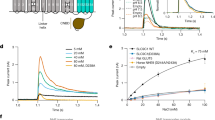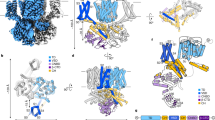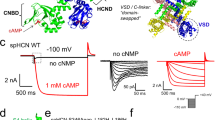Abstract
Sea urchin eggs attract sperm through chemotactic peptides, which evoke complex changes in membrane voltage and in the concentrations of cyclic AMP, cyclic GMP and Ca2+ ions (see ref. 1 for a review). The intracellular signalling pathways and their cellular targets are largely unknown. We have now cloned, from sea urchin testis, the complementary DNA encoding a channel polypeptide, SPIH. Functional expression of SPIH gives rise to weakly K+-selective hyperpolarization-activated channels, whose activity is enhanced by the direct action of cAMP. Thus, SPIH is under the dual control of voltage and cAMP. The SPIH channel, which is confined to the sperm flagellum, may be involved in the control of flagellar beating. SPIH currents exhibit all the hallmarks of hyperpolarization-activated currents (Ih)2,3, which participate in the rhythmic firing of central neurons, control pacemaking in the heart, and curtail saturation by bright light in retinal photoreceptors2,3. Because of their sequence4 and functional properties, Ih channels form a class of their own within thesuperfamily of voltage-gated and cyclic-nucleotide-gated channels.
This is a preview of subscription content, access via your institution
Access options
Subscribe to this journal
Receive 51 print issues and online access
$199.00 per year
only $3.90 per issue
Buy this article
- Purchase on Springer Link
- Instant access to full article PDF
Prices may be subject to local taxes which are calculated during checkout





Similar content being viewed by others
References
Ward, C. R. & Kopf, G. S. Molecular events mediating sperm activation. Dev. Biol. 158, 9–34 (1993).
DiFrancesco, D. Pacemaker mechanisms in cardiac tissue. Annu. Rev. Physiol. 55, 455–472 (1993).
Pape, H.-C. Queer current and pacemaker: the hyperpolarization-activated cation current in neurons. Annu. Rev. Physiol. 58, 299–327 (1996).
Santoro, B., Grant, S. G. N., Bartsch, D. & Kandel, E. R. Interactive cloning with the SH3 domain of N-src identifies a new brain specific ion channel protein, with homology to Eag and cyclic nucleotide-gated channels. Proc. Natl Acad. Sci. USA 94, 14815–14820 (1997).
Heginbotham, L., Abramson, T. & MacKinnon, R. Afunctional connection between the pores of distantly related ion channels as revealed by mutant K+ channels. Science 258, 1152–1155 (1992).
Heginbotham, L., Lu, Z., Abramson, T. & MacKinnon, R. Mutations in the K+ channel signature sequence. Biophys. J. 66, 1061–1067 (1994).
Finn, J. T., Grunwald, M. E. & Yau, K.-W. Cyclic nucleotide-gated ion channels: an extended family with diverse functions. Annu. Rev. Physiol. 58, 395–426.
DiFrancesco, D. Characterization of the pace-maker current kinetics in calf Purkinje fibres. J. Physiol. 348, 341–367 (1984).
Hagen, V.et al. Caged compounds of hydrolysis-resistant analogues of cAMP and cGMP: synthesis and application to cyclic nucleotide-gated channels. Biochemistry 35, 7762–7771 (1996).
DiFrancesco, D. & Mangoni, M. Modulation of single hyperpolarization-activated channels (If) by cAMP in the rabbit sino-atrial node. J. Physiol. 474, 473–482 (1994).
Beavo, J. A. Cyclic nucelotide phosphodiesterases: functional implications of multiple isoforms. Physiol. Rev. 75, 725–748 (1995).
Wollmuth, L. P. & Hille, B. Ionic selectivity of Ihchannels of rod photoreceptors in tiger salamanders. J.Gen. Physiol. 100, 749–765 (1992).
DiFrancesco, D. & Tortora, P. Direct activation of cardiac pacemaker channels by intracellular cyclic AMP. Nature 351, 145–147 (1991).
Trudeau, M. C., Warmke, J. W., Ganetzky, B. & Robertson, G. A. HERG, a human inward rectifier in the voltage-gated potassium channel family. Science 269, 92–95 (1995).
Smith, P. L., Baukrowitz, T. & Yellen, G. The inward rectification mechanism of the HERG cardiac potassium channel. Nature 379, 833–836 (1996).
Labarca, P.et al. AcAMP regulated K+-selective channel from the sea urchin sperm plasma membrane. Dev. Biol. 174, 271–280 (1996).
Babcock, D. F., Bosma, M. M., Battaglia, D. E. & Darszon, A. Early persistent activation of sperm K+ channels by the egg peptide speract. Proc. Natl Acad. Sci. USA 86, 6001–6005 (1992).
Hansbrough, J. R. & Garbers, D. L. Speract — purification and characterization of a peptide associated with eggs that activates spermatozoa. J. Biol. Chem. 256, 1447–1452 (1981).
Darszon, A., Labarca, P., Beltrán, C., García-Soto, J. & Liévano, A. Sea urchin sperm: an ion channel reconstitution study case. Methods: a Companion Methods Enzymol. 6, 37–50 (1994).
Bönigk, W.et al. Rod and cone photoreceptor cells express distinct genes for cGMP-gated channels. Neuron 10, 865–877 (1993).
Baumann, A., Frings, S., Godde, M., Seifert, R. & Kaupp, U. B. Primary structure and functional expresion of a Drosophila cyclic nucleotide-gated channel present in eyes and antennae. EMBO J. 13, 5040–5050 (1994).
Pongs, O.et al. Shaker encodes a family of putative potassium channel proteins in the nervous system of Drosophila. EMBO J. 7, 1087–1096 (1988).
Warmke, J., Drysdale, R. & Ganetzky, B. Adistinct potassium channel polypeptide encoded by the Drosophila eag locus. Science 252, 1560–1562 (1991).
Warmke, J. W. & Ganetzky, B. Afamily of potassium channel genes related to eag in Drosophila and mammals. Proc. Natl Acad. Sci. USA 91, 3438–3442 (1994).
Anderson, J. A., Huprikar, S. S., Kochian, L. V., Lucas, W. J. & Gaber, R. F. Functional expression of a probable Arabidopsis thaliana potassium channel in Saccharomyces cerevisiae. Proc. Natl Acad. Sci. USA 89, 3736–3740 (1992).
Kaupp, U. B.et al. Primary structure and functional expression from complementary DNA of the rod photoreceptor cyclic GMP-gated channel. Nature 342, 762–766 (1989).
Ludwig, J., Margalit, T., Eismann, E., Lancet, D. & Kaupp, U. B. Primary structure of cAMP-gated channel from bovine olfactory epithelium. FEBS Lett. 270, 24–29 (1990).
Titani, K.et al. Amino acid sequence of the regulatory subunit of bovine type I adenosine cyclic 3′,5′-phosphate dependent protein kinase. Biochemistry 23, 4193–4199 (1984).
Takio, K.et al. Guanosine cyclic 3′,5′-phosphate dependent protein kinase, a chimeric protein homologous with two separate protein families. Biochemistry 23, 4207–4218 (1984).
Aiba, H., Fujimoto, S. & Ozaki, N. Molecular cloning and nucleotide sequencing of the gene for E. coli cAMP receptor protein. Nucleic Acids Res. 10, 1345–1361 (1982).
Acknowledgements
We thank H. Breer for providing a cDNA clone that encodes a Heliothes SPIH homologue; J. E. Brown, E. Eismann, and I. Weyand for careful reading of the manuscript; A. Eckert for preparing the manuscript; and H. Schauf for the illustrations. R.G. was the recipient of a stipend from the Boehringer Ingelheim Fonds.
Author information
Authors and Affiliations
Corresponding author
Rights and permissions
About this article
Cite this article
Gauss, R., Seifert, R. & Kaupp, U. Molecular identification of a hyperpolarization-activated channel in sea urchin sperm. Nature 393, 583–587 (1998). https://doi.org/10.1038/31248
Received:
Accepted:
Issue Date:
DOI: https://doi.org/10.1038/31248
This article is cited by
-
Gating intermediates reveal inhibitory role of the voltage sensor in a cyclic nucleotide-modulated ion channel
Nature Communications (2022)
-
Ion channel profiling of the Lymnaea stagnalis ganglia via transcriptome analysis
BMC Genomics (2021)
-
Electromechanical coupling mechanism for activation and inactivation of an HCN channel
Nature Communications (2021)
-
BrCNGC gene family in field mustard: genome-wide identification, characterization, comparative synteny, evolution and expression profiling
Scientific Reports (2021)
-
Gating mechanism of hyperpolarization-activated HCN pacemaker channels
Nature Communications (2020)
Comments
By submitting a comment you agree to abide by our Terms and Community Guidelines. If you find something abusive or that does not comply with our terms or guidelines please flag it as inappropriate.



